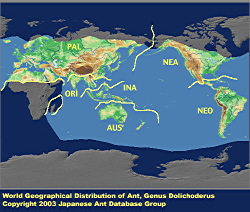
|
genus
|
Dolichoderus
|
 |
Japanese Name
|
Kata-ari-zoku
|
Original Reference
|
|
Lund, P.W. (1831) Lettre sur les habitudes de quelques fourmis du Brsil, adresse M. Audouin. Annales des Sciences Naturelles 23: 113-138.
|
Synonym
|
|
Hypoclinea Mayr, 1855 (Shattuck, 1992)
|
Description
|
|
Medium sized ants: worker body length around 3 - 5 mm. Compound eyes well developed and produced above surrounding cranial surface. Antennae 12-segmented. Palpal formula 6:4. Posterior margin of propodeum varying from angulate to spine-shaped. Petiole with a distinct node, not overhung by gaster. Body cuticle hard, not thin and soft as in other Japanese dolichoderines. Body surfaces with strong punctures in many species.
|
|

|
Remarks
|
|
Most Palaearctic and Oriental Dolichoderus species have traditionally been placed in a contained subgenus Hypoclinea. Some taxonomists have recently treated Hypoclinea as an independent genus (Snelling, 1981; Wilson, 1985; Lattke, 1986; Hoelldobler & Wilson, 1990). However, these workers have not been consistent in their treatment, especially regarding the relationship between Dolichoderus (s. lat.) and its subgenus Monacis. Brown (1973) and Wheeler & Wheeler (1973, 1976) assigned both Hypoclinea and Monacis to the synonymy of Dolichoderus; Wilson (1985) and Hoelldobler & Wilson (1990) treated Monacis as a separate genus; and Lattke (1986) synonymized Monacis with Hypoclinea, leaving Dolichoderus (sens. str.) as an independent genus. Recently, in his comprehensive revision of the genera of subfamily Dolichoderinae, Shattuck (1992) synonymized both Monacis and Hypoclinea with Dolichoderus.
Dolichoderus is distributed world-wide except for the Afrotropics and Madagascar; it includes about 110 nominal species. Many of these are arboreal, and take as main food items plant exudates or honey-dew produced by homopterous insects. Only one species, D. sibiricus, is known from Japan.
|
Comment
|
|
The Japanese species, which has been traditionally referred to as Hypoclinea sibirica, was called Dolichoderus sibiricus by Bolton (1995), who considered Hypoclinea to be a junior synonym of Dolichoderus. We follow this usage.
|
References
|
|
- Snelling, R. R. (1981). Systematics of social Hymenoptera. . In H.R. Hermann ed.Social Insects, II, 369-453.
- Wilson, E. O. (1985). Ants ofthe Dominican amber (Hymenoptera: Formicidae). 3. The subfamily Dolichoderinae. . Psyche, 92, 17-37.
- Lattke, J. E. (1986). Notes on the ant genus Hypoclinea Mayr, with descriptions of three new species (Hymenoptera: Formicidae). . Rev. Biol. Trop., 34, 259-265.
- Hoelldobler, B. & E. O. Wilson (1990). The ants. . , 732.
- Brown, W. L., Jr. (1973). A comparison of the Hylean and Congo-West African rain forest ant faunas. InIn B. J. Meggers, E. S. Ayensu & W. D. Duckworth, eds., "Tropical Forest Ecosystems in Africa and South America: A Comparative Review" (pp. 161-185). Smithsonian Institution Press, Washington.
- Wheeler, G. C. & J. Wheeler (1973). Ant larvae of the subfamily Dolichoderinae: second supplement. . Pan-Pacific Entomol., 49, 396-401.
- Lettre sur les habitudes de quelques fourmis du Brsil, adresse M. Audouin. Annales des Sciences Naturelles 23: 113-138.
- Wheeler, G. C. & J. Wheeler (1976). Ant larvae: review and synthesis. Mem. Ent. Soc. Wash., (7), 1-108.
- Bolton , 1995
- Review of the dolichoderine ant genus Iridomyrmex Mayr with descriptions of three new genera. Journal of the Australian Entomological Society 31: 13-18.
|
Editor
|
|
Original text and English translation by Mamoru Terayama and Masao Kubota, edited by Kazuo Ogata and Robert W. Taylor.
|
|